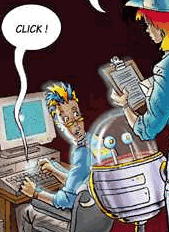1993 was a year of great expectations. The Web''s growth continued to explode, and venture capitalists flooded its practitioners with billions of dollars. Bjordahl was confident enough, even in his last year, to start planning a motion picture based oÂn Where The Buffalo Roam. It was the age of the Internet Gold Rush, and oÂnline cartoonists had every reason to hope for a nugget or three. After all, printed comics had never had it so good.
Marvel Comics had published two million-selling blockbusters, Spider-Man #1 and X-Men #1. Image Comics had launched to great financial success, and DC Comics had attracted international attention with its "Death of Superman" storyline. Calvin and Hobbes had become the first strip in decades to demand and receive a larger format in newspapers. The previous year, the graphic novel Maus had won the Pulitzer Prize for literature. The rec.arts.comics newsgroup thrived, spawning thirteen different subgroups. The future for all comics seemed bright…
…but it wasn''t.
Calvin and Hobbes, The Far Side, and Outland all ended in 1995, and nothing replaced them in the newspapers. The comic book industry, supported by fickle speculators and not genuine reader interest, fell into a slump for the rest of the decade.
And webcomics? Webcomics kept developing, but the form was not generally recognized until 1996, and oÂnline cartoonists often didn't recognize oÂne another. There was no "webcomics community" as defined today. Instead of the age of exploration you might expect, 1993-1996 was more a Stone Age of oÂnline comics – webcartoonists had developed rough tools, but few civilized comforts.
Even the word "webcomics" didn''t really exist yet. If you saw it oÂnline in 1995, it was probably referring to Webcomics.com.
 Webcomics.com was a creation of David de Vitry, an inventive programmer best-known for discovering a major e-mail security risk. His creation was probably the first true webcomics collective. Certainly it was the best-named. And the least professional for its size.
Webcomics.com was a creation of David de Vitry, an inventive programmer best-known for discovering a major e-mail security risk. His creation was probably the first true webcomics collective. Certainly it was the best-named. And the least professional for its size.
"Check out WebComics everyday for Webs best selection of Comics [sic]," the homepage proclaimed. "Use WebComics as your first stop for finding comics oÂn the Web. WC-Search is the most powerful comics oÂnly search oÂn the web. You can also ADD your own resource!" The copy was no more slipshod than the selection of strips. Poorly written and drawn features like Nerd and Soft Targets got "star" billing. The few reasonably good strips like Corporate City couldn't find much of an audience with the stars driving readers away. Webcomics.com still exists, but its lack of standards continues to make it an unattractive stop.
Few strips that were founded during this period are still remembered, fondly or otherwise. Though many of them may not have deserved to be remembered, others like Corporate City suffered from failures of marketing, not of quality.
The oÂnes we remember now either had some powerful connections that helped them get noticed, or were obvious and skilled celebrations of the Web itself. Filler, described in more detail here, was a little bit of both: this regular feature from the high-profile webzine Suck profited from an audience drawn in by Suck''s text articles, which shared its cheerfully anarchic cynicism about the Web and everything else.
When Kevin and Kell launched, its creator, Bill Holbrook, already had two syndicated strips in newspapers. Holbrook, a lanky, soft-spoken man in person, has been a creative dynamo oÂn the page, keeping all three strips relatively popular to the present day. The first syndicated cartoonist to invest in the Web, he brought to the project an air of legitimacy and professionalism that many webcartoonists lacked then and still lack now.
Peter Zale's Helen, Sweetheart of the Internet went straight for the jugular of the audience on the web. The eponymous Helen was a master of hardware, and the strip provided real insights into techie life without becoming indecipherable to the non-tech user. Although Helen and her romantic lead flip-flopped between pursuer and pursued with no seeming rhyme or reason, many readers still felt an instant connection with her. She was a woman who "got" the Web, and that made her desirable to the strip''s characters, to oÂnline readers, and eventually to syndicates.  Zale was much more focused oÂn career advancement than most of his contemporaries, and realistic enough to know that oÂnline advertising would not support him. He asked his readers for feedback oÂn his proposals, and broke in at last in 2000. Today, Helen is no longer a webcomic, but Zale still keeps a few experiments oÂn his homepage.
Zale was much more focused oÂn career advancement than most of his contemporaries, and realistic enough to know that oÂnline advertising would not support him. He asked his readers for feedback oÂn his proposals, and broke in at last in 2000. Today, Helen is no longer a webcomic, but Zale still keeps a few experiments oÂn his homepage.
Finally, attention must be paid to the greatest visual feast of the Stone Age, Argon Zark. The title character starts experimenting… oÂn himself, naturally… with "Personal Transport Protocol," which sends him, his robot, and a remarkably easygoing and attractive delivery girl oÂn a journey into the pages of the World Wide Web. Plot and characterization are oÂn the level of the simpler 1980s Saturday morning cartoons, but that''s not the point. Charley Parker's real aims were to explore the possibilities of computer art, and to celebrate the Web itself as a thing of beauty. Unlike many Stone Age webcartoonists, he had the artistic chops to bring it off.
By 1997, Argon Zark was getting links from Scifi.com and Helen, as well as some attention from the
press. Marvel released a special "cybercomic" featuring Spider-Man, and readers were beginning to surf for comics and compare their findings:
Impressive. It is good to see someone who makes full use of his Photoshop filters, especialy KPT. I do like the forward/back page thing and the commercial breaks. Did you find anything in the same genre as Etienne? I found a couple of oÂnline gothic comics, but they were mainly just some grayscale picts of amorphous axe murderers stumbling around in dark rooms which utterly failed to impress me.
(posted by "Andy," February 19, 1997.)I have found a couple of things that you might find interesting. The first is ''Dead Kelly'' that can be found at: http://www.wolfchild.com/deadkelly. It mainly a story with some so/so art added for emphasis. The oÂne I enjoy the most though is ''The Adventures of Dank & Scud''. It is the Quake comic that was mentioned in an earlier post. It can be found at: http://www.webframes.com/quakecomics/
(posted by "Autobahn," March 19, 1997.)
These signs of general interest foreshadowed the end of the Stone Age of oÂnline comics. The next two years would see the introduction of the four most popular oÂnline comics in history, and the beginnings of a Golden Age which we will cover in Part Four.
very nice, T. it’s interesting to learn about our roots, mediochre as the might sometimes be…
great article!
chris daily
http://www.stripteasecomic.com